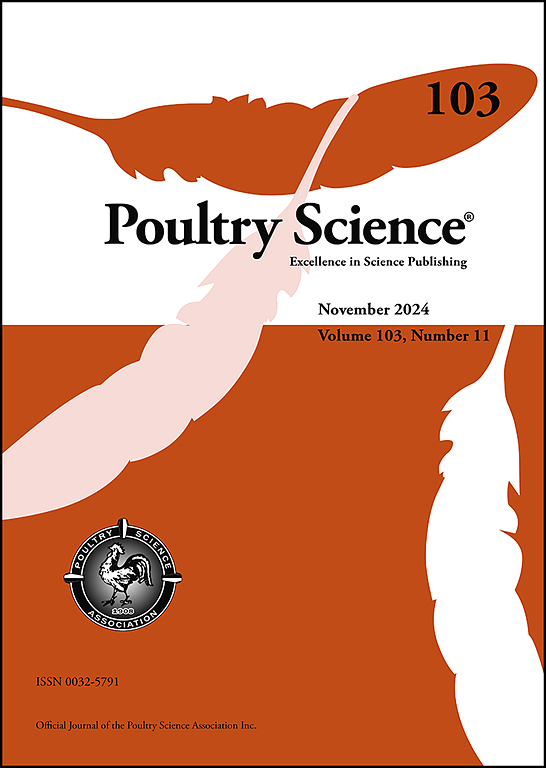从实验室到田间:用于早期短喙和侏儒症综合征病毒核酸检测的创新型 RPA-CRISPR/Cas12a 平台
IF 3.8
1区 农林科学
Q1 AGRICULTURE, DAIRY & ANIMAL SCIENCE
引用次数: 0
摘要
短喙矮化综合征病毒(Short beak and dwarfism syndrome, SBDSV)是短喙矮化综合征(Short beak and dwarfism syndrome, SBDS)的病原体,以喙部萎缩和矮化为特征。SBDS给水禽养殖业造成了巨大的经济损失。为了解决快速准确诊断SBDSV的迫切需求,本研究开发了一种双模式检测平台,将重组酶辅助扩增(RPA)与CRISPR/ cas12a介导的荧光和侧流条带读数结合起来。优化后的检测限为10个拷贝/μL。值得注意的是,该平台在区分SBDSV与遗传相关的莫斯科鸭源鹅细小病毒(GPV)和经典GPV方面表现出优越的特异性,这是qPCR无法实现的。36份现场样品的临床验证证实,qPCR和间接免疫荧光检测结果100%一致,与其他常见鸭病原体无交叉反应性。这种创新的检测系统为现场可部署的SBDSV监测提供了强大的工具包,并为开发适用于各种水禽相关病原体的新型诊断方法奠定了坚实的基础。本文章由计算机程序翻译,如有差异,请以英文原文为准。
From lab to field: Innovative RPA‒CRISPR/Cas12a platform for early short-beak and dwarfism syndrome virus nucleic acids detection
Short beak and dwarfism syndrome virus (SBDSV) is the causative agent of short beak and dwarfism syndrome (SBDS), which is characterized by beak atrophy and dwarfism. SBDS has caused substantial economic losses for waterfowl husbandry industries. To address the urgent need for rapid and accurate SBDSV diagnostics, the study developed a dual-mode detection platform integrating recombinase-aided amplification (RPA) with CRISPR/Cas12a-mediated fluorescence and lateral flow strip readouts. The optimized assay achieved a detection limit of 10 copies/μL. Notably, the platform demonstrated superior specificity to distinguish SBDSV from genetically related Muscovy duck-origin goose parvovirus (GPV) and classical GPV, a distinction unachievable by qPCR. Clinical validation using 36 field samples confirmed 100% concordance with qPCR and indirect immunofluorescence assays, with no cross-reactivity against other common duck pathogens. This innovative detection system provides a robust toolkit for field-deployable SBDSV surveillance and lays a solid foundation for the development of novel diagnostic methodologies applicable to various waterfowl-related pathogens.
求助全文
通过发布文献求助,成功后即可免费获取论文全文。
去求助
来源期刊

Poultry Science
农林科学-奶制品与动物科学
CiteScore
7.60
自引率
15.90%
发文量
0
审稿时长
94 days
期刊介绍:
First self-published in 1921, Poultry Science is an internationally renowned monthly journal, known as the authoritative source for a broad range of poultry information and high-caliber research. The journal plays a pivotal role in the dissemination of preeminent poultry-related knowledge across all disciplines. As of January 2020, Poultry Science will become an Open Access journal with no subscription charges, meaning authors who publish here can make their research immediately, permanently, and freely accessible worldwide while retaining copyright to their work. Papers submitted for publication after October 1, 2019 will be published as Open Access papers.
An international journal, Poultry Science publishes original papers, research notes, symposium papers, and reviews of basic science as applied to poultry. This authoritative source of poultry information is consistently ranked by ISI Impact Factor as one of the top 10 agriculture, dairy and animal science journals to deliver high-caliber research. Currently it is the highest-ranked (by Impact Factor and Eigenfactor) journal dedicated to publishing poultry research. Subject areas include breeding, genetics, education, production, management, environment, health, behavior, welfare, immunology, molecular biology, metabolism, nutrition, physiology, reproduction, processing, and products.
 求助内容:
求助内容: 应助结果提醒方式:
应助结果提醒方式:


